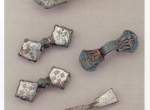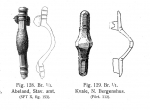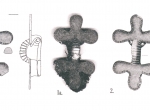Equal-armed brooch
Equal-armed brooch (gleicharmige Bügelfibel), dress accessory typical for the Merovingian period and for the onset of the early medieval period (late 6th to 9th centuries) seen in many areas of Europe, from Scandinavia and England to south-eastern Europe (fig. 1-3.), also on the territory of today’s Poland (especially, the area settled by West Balt cultures →Balts ). On the brooch head and foot, two identical, symmetrical plates - half-round, triangular, rectangular, trapezoid, lozengic, cruciform, more rarely, zoomorphic; some plates may have projections. The plates may be plain or ornamented: with stamped designs (a frequent motif - concentric rings), linear designs - engraved or chip carved/Kerbschnitt →Kerbschnitt Style , sometimes, also in the animal style. The bow is plain or facetted, sometimes with a metope on top; plain or ornamented: linear motifs (stamped, engraved, Kerrbschnitt). Some specimens are decorated with crosswise ribs, spaced symmetrically on the head, bow and foot, also set with almandines.
AB-W
Literature: H. Shetelig, Smaa broncespænder fra folkevanderingstiden, „Oldtiden. Tidskrift for Norsk forhistorie“ 1 (1910), 1911, p. 51-99; W. Hübener, Gleicharmige Bügelfibeln der Merowingerzeit in Westeuropa, Madrider Mitt. 13, 1972, p. 211f.; S. Thörle, Gleicharmige Bügelfibeln des frühen Mittelalters, Universitätsforschungen zur prähistorischen Archäologie 81, Bonn 2001.
-
 full resolution
full resolution
Fig. 1. Equal-armed brooches from France (Corbie and Marchélepot, Dép. Somme; Azy-sur-Marne, Dép. Aisne), 7th century (Merowingerzeit. Die Altertümer im Museum für Vor- und Frühgeschichte, Mainz a.R. 1995, Plate 57).
-
 full resolution
full resolution
Fig. 2. Scandinavian equal-armed brooches (N. Åberg, Den nordiska folkvandringstidens kronologi, Stockholm 1924, Fig. 127–130).
-
 full resolution
full resolution
Fig. 3. A pair of equal-armed brooches from barrow 33 (grave 1) at Czerwony Dwór, site XXI (P. Šimanski, L. Godzeba, Mogilnik sudovskoj kultury v Červonom Dvore – predvaritelnyje rezultaty issledovanij v 2003-2005 godach, Archaeologia Lituana 7, Vilnius 20


